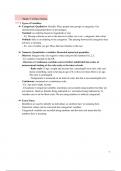Exam (elaborations)
Statistics Videos Summary EPH1026
- Course
- Institution
This document is an extensive summary of all the videos that students have to watch in order to understand the statistical concepts. This document is divded into Week 1, Week 2, Week 3 and Week 4. There is thorough explanation of the content for all the videos including some examples too.
[Show more]



